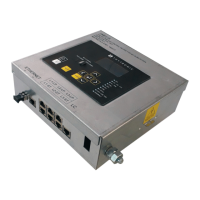46
46
SME2-IS - Manual - 06 - 2021
FUNCTIONAL CHARACTERISTICS
The gure below shows a rapid reclosing followed by a fault which opens the breaker within the
neutralisation time followed by a slow reclosing run on the fault within the discrimination time td1;
the reclosing is considered unsuccessful and the respective report is issued.
Rapid reclosing + slow
reclosing and subsequent
memorized reclosings
The gure below shows a rapid reclosing followed by a fault which opens the breaker within the
neutralisation time, followed by a slow reclosing and a fault detected beyond t
d1
but within the neu-
tralisation time t
r
; when t
r
times out, the memorized reclosing is run.
If the line is MIXED, t
d1
=0; if the fault occurs immediately, the sequence proceeds with a non-deni-
tive trip and wait for the rst memorized reclosing.
If the line is CABLE, t
d1
=5 s; if the fault recurs within t
d1
, the sequence continues with a denitive trip
and signals unsuccessful reclosing.
MIXED line
If the line is MIXED, and the fault occurs within t
r
, the sequence opens the breaker and the following
memorized reclosing is run when t
r
expires. Every subsequent memorized reclosing starts timers t
r
and t
d2
. If a fault occurs within t
r
, but after t
d2
, the sequence opens the breaker and the next memo-
rized reclosing occurs when t
r
expires; if, on the other hand, the fault is detected within t
d2
, a deni-
tive trip occurs and an unsuccessful reclosing is reported.
CABLE line
If the line is CABLE and a fault occurs within t
r
, but after t
d1
, the sequence opens the breaker and the
next memorized reclosing occurs when t
r
expires; if, on the other hand, the fault is detected within
t
d1
, a denitive trip occurs and an unsuccessful reclosing is reported. The sequence is repeated for
the congured number of memorized reclosings, using t
d2
in place of t
d1
.
After a denitive trip, each intentional closing (local or remote) starts t
r
.
If no tripping condition occurs within t
r
, the automation must change to the state denominated FA, in
which further automatic reclosing are disabled, thus enabling manual troubleshooting of the non-au-
tomated branch lines.
In FA status, any new detection of a fault must generate a denitive trip issued in base time, accom-
panied by an unsuccessful closing signal FR.
The FA status concludes when timer t
fa
expires. From that time on, every new fault detected will be
part of a new reclosing cycle.
t
Neutralisation timer
Discrimination timer
td1
Failed reclosing
Rapid reclosing followed by fault and subsequent slow reclosing on fault
t
Neutralisation timer
Discrimination timer
td1 td2
Failed reclosing
Rapid reclosing followed by fault and subsequent slow and memorized reclosings

